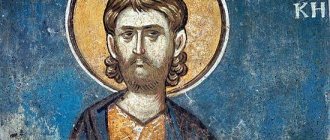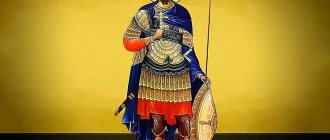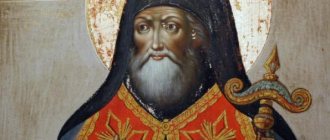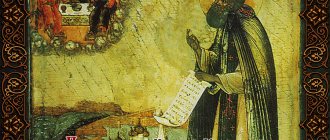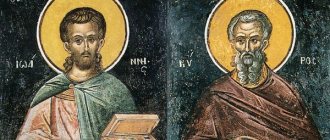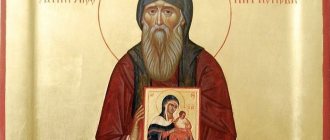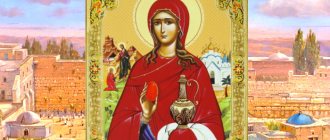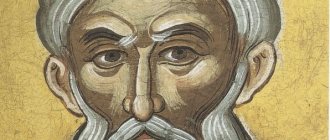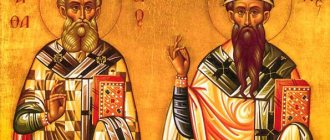Evfimy of Suzdal
(1316 - 1404), archimandrite, venerable
Commemorated April 1 on the day of death, July 4 on the day of the discovery of relics, in the Cathedrals of the Nizhny Novgorod and Radonezh saints
Born in 1316 in Nizhny Novgorod. From early childhood he was taught to read and write and received spiritual education.
He took monastic vows at the Nizhny Novgorod Pechersk Monastery from its founder, Saint Dionysius of Suzdal. The exploits of Saint Euthymius were so great that Saint Dionysius advised him to reduce them.
In 1352, the Suzdal prince Boris Konstantinovich decided to found a monastery in his city and turned to the Nizhny Novgorod Pechersk monastery with a request to send a monk to create a monastery. The choice of the holy abbot fell on the Monk Euthymius. After the arrival of the Monk Euthymius in Suzdal, in the northern part of the city, beyond the Kamenka River, the Suzdal Saint John, in front of a huge crowd of people, erected a cross on the site of the future monastery cathedral. The prince himself began to dig the ground for the foundation, and the Monk Euthymius hewed out three grave stones for himself; having vowed to remain in the new monastery for the rest of his life. Thus was laid the foundation of the Transfiguration of the Savior Euthymius Monastery, where more than three hundred monks soon gathered under the leadership of the monk. The monastery adopted a communal charter. The monk especially made sure that each of the monks was ready to fulfill any obedience. The Monk Euthymius often went for spiritual advice to the Trinity-Sergius Monastery to the Monk Sergius of Radonezh (+ 1392). Saint Euthymius was a strict ascetic and a great man of prayer. He worked tirelessly for the benefit of all the brethren.
The Monk Euthymius died on April 1, 1404.
Life of the Holy Wonderworker Euthymius of Suzdal
The Wonderworker Euthymius of Suzdal lived at the same time as such revered saints as Sergius of Radonezh and Metropolitan of Moscow, St. Alexy. The Life of St. Euthymius was written by the monk Gregory.
Origin
The saint and wonderworker Euthymius was born in 1316 in Nizhny Novgorod, which at that time was part of the Suzdal principality. Information about who his parents were is not indicated in the life, but it can be assumed that they were pious people who raised their son in the spirit of Christian meekness and humility. In addition, they sent the child to learn to read and write, so one can come to the conclusion that they had wealth, because ordinary peasants could not afford it.
From an early age, Euthymius (this name was given to him at tonsure, but the worldly remains unknown) delved into the study of the Holy Scriptures, and his thoughts were aimed at devoting his life to serving the Lord.
Since childhood, his behavior was very different from the behavior of his peers - the boy was not attracted to noisy games and entertainment, he devoted every free minute to reading the Bible and soul-helping books. He grew up silent and modest, immersed in the study of sacred books.
The second school of piety, in addition to books, for the boy was the Christian temple, which he constantly visited. And there, as at school, he preferred solitude, standing in the corner, he prayed to the Lord and listened to the chants with reverence. At that time, he often heard stories of holy men who had renounced worldly pleasures and spent their time in prayer and fasting, and preaching the Word of God. The decision to follow their example matured in his soul in order to receive from the Almighty the promised benefits and eternal life after death.
Some time passed, and the young man at a church service heard the words of the Lord that whoever wants to be His servant must leave his relatives and family, take up his cross and follow Him. Having finally made his decision, Euthymius went to the Pechora Monastery, which was located not far from Nizhny Novgorod, to take monastic vows.
Serving God
The Pechora Monastery was built in honor of the Ascension of the Lord by Saint Dionysius, who was a tonsure of the Kiev Pechersk Monastery and a close spiritual friend of Sergius of Radonezh. Arriving at the monastery, the young man opened his heart to the clergy and spoke about his decision to forever renounce earthly goods, asking them to tonsure him as a monk. The rite was personally performed by Saint Dionysius, and after that another life began for Euthymius, filled with daily prayers and other monastic labors.
The young man performed his monastic work with great love and great zeal. He took upon himself to carry out the most difficult obediences and never complained, completely obeying the will of the abbot of the monastery. He carried water for the needs of the brethren, chopped wood and did work in the kitchen and in the field, while realizing that by doing this he served the Almighty. Despite the fact that Evfimy worked hard all day, at night he practically did not sleep, spending most of his time in prayer. The young monk ate very modestly and drank only water. Seeing such humility and patience of the monk, other inhabitants of the monastery considered him an angel who descended to earth to people.
In 1352, the Suzdal prince Boris Konstantinovich decided to build a new monastery in the city and turned to Saint Dionysius to advise him of someone who would lead the construction of the monastery and subsequently become its abbot. Saint Dionysius immediately thought of Euphemia and entrusted him with a new ministry.
On the shore of the lake, in a picturesque place, a temple and hermitage were founded in the name of St. Basil the Great. Having asked for the blessing of St. John, Euthymius made a vow not to leave this monastery until his death. Near the holy altar, located near the northern gate of the altar, the abbot cut three stones with his own hands to prepare a coffin for himself. The miracle worker’s body was subsequently placed in it after he reposed.
The monastery that was built grew very quickly, and there were about 300 monks in it. Then Saint John elevated Euthymius to the rank of archimandrite. In addition to the monastery, with the blessing of the saint, the Wonderworker built a temple in the name of John Climacus, as well as the Intercession Convent.
Throughout his pious life, Evfimy of Suzdal was distinguished by his strict attitude towards ascetic service - he himself was content with simple monastic clothing and meager food, and he taught the same to his brethren. In the monastery of the miracle worker, the poor and sick found shelter and food; he often paid debts for those in trouble and protected ordinary people from oppression by the nobility.
Demise
The Monk Euthymius lived a long life and died at a ripe old age. When the saint felt that his path on earth was nearing its end, he called the entire monastery brethren to him. He asked everyone for forgiveness if he had offended them by accident, and also said words of guidance and consolation. After receiving Holy Communion, the monk reposed - this happened on April 1, 1404.
However, even after his death, Euthymius of Suzdal became famous for his miracles. The life describes a case when the cellarer of the monastery violated the commandment, according to which the brethren were forbidden to eat food outside the common meal. At night, in a dream, a saint appeared to him with a lit torch and a candle in his hands. The cellarer was horrified and repented of what he had done, but after some time he again began to violate the monastic custom. Euthymius appeared to him again and punished Cyprian by relaxing all his limbs. The cellarer received healing only at the grave of the saint after sincere repentance.
Relics and veneration
On July 4, 1507, while digging a ditch for the new cathedral church, his incorruptible relics were discovered. The saint was glorified at the Council of 1549.
At the beginning of the 21st century, the relics of the saint ended up in the hands of the so-called. "Russian Orthodox Autonomous Church" (ROAC). The Vladimir diocese has repeatedly stated that it considers it illegal for schismatics to keep the shrine. After many years of proceedings, at the end of March 2015, the shrine - as “state property” - was seized from the ROAC and transferred to the Vladimir administration of the Federal Property Management Agency, which soon transferred the relics for the use of the Vladimir diocese of the canonical Church. The return of the shrine was marked by a solemn bishop's Divine Liturgy in the Cathedral of the Deposition of Robe Monastery on April 14 of that year. After the liturgy, the procession with the relics of St. Euthymius went from the Robe to the Alexander Monastery where the shrine was placed in the Ascension Cathedral [1].
"Unpromoted Saint"
Conversation with the rector of the Spaso-Evfimiev Monastery, Hieromonk Arseny (Smirnov)
Founded in the mid-14th century, the Spaso-Evfimiev Monastery was an outpost of the Suzdal-Nizhny Novgorod principality.
Its first abbot was Saint Euthymius, “spiritual interlocutor” and associate of Sergius of Radonezh. Initially the monastery was called Spaso-Preobrazhensky. But after the discovery in 1507 of the relics of the saint, who was revered not only in Suzdal, but throughout Rus', the monastery began to be called Spaso-Evfimiev. Today the monastery is open to both believers and those interested in history: the monastery is a UNESCO World Cultural Heritage Site and is part of the Vladimir-Suzdal Museum-Reserve. The rector of the monastery, Hieromonk Arseny (Smirnov), talks about the modern life of the monastery, about the miraculous discovery of the relics of St. Euthymius.
– Father Arseny, today – April 1/14 – is a holiday in the monastery: the memory of St. Euthymius of Suzdal. What is the current status of the monastery?
– Spaso-Evfimiev Monastery is a museum complex. But we, monks, are here every day. Before the pandemic, there were daily services here. But in March last year, by order of the Ministry of Culture, services at the monastery stopped, and the museum itself was completely closed to tourists. We are now serving on Sundays again. On the patronal feast day, the service will, of course, be performed.
There were no services during the pandemic, and museum workers asked for services to be returned. People felt a lack of prayer
– Which of the church hierarchs contributed to the flourishing of the monastery?
– Hieromartyr Seraphim (Chichagov). During the five years of his abbotship - from 1899 to 1904 - many things changed beyond recognition in the monastery. The cathedral has been restored. Buildings and two gymnasiums were built - for boys and for girls. The brethren increased to 460 people. A major restoration was carried out. This was a real salvation for our monastery.
About 10 thousand people live in Suzdal. There are 12 saints in the entire city. All of them can be considered patrons of the city. The Monk Euthymius is included in this number, but I would not single him out as the only heavenly patron. At the same time, its monastery can be called an architectural dominant. This is the largest monastery; in size it is not inferior to the Trinity-Sergius Lavra. There were periods of decline, of course. But thanks to the work of the museum and the work of museum workers, much has been preserved.
– Father Arseny, who is Saint Euthymius for you?
“I grew up in front of his relics.” I live directly opposite the temple where his relics were. I was always afraid of him. He always seemed very strict to me. Even now, when I change it, I have a feeling of trepidation. The monastery has many attached churches: the Cathedral of the Mother of God of the Nativity, where the relics of St. John; The Assumption Church, where the relics of Archbishop Arseny of Suzdal lie, in whose honor I was tonsured. The relics have to be regularly redressed. But the strongest inner awe, not even fear, but the strongest reverence, is before the relics of Saint Euthymius.
You see, his example is very important to me. This feat requires discipline and work. This example from childhood is before my eyes. With his example, he infected everyone around him. You know, you can go out to preach, try to influence the psyche, but if you yourself do not live what you teach, then such a sermon is worthless. People need to be told what you do yourself. The Monk Euthymius just showed the townspeople and the brethren of the monastery what real asceticism is.
His feat obliges him to discipline and work. And this example from childhood is before my eyes
– What caused this surge of interest in spiritual exploits and renunciation of the world in the 14th century?
– That era is truly famous for its spiritual uplift. It is characterized by severity, first of all, in relation to God. Strictness in the implementation of rules, steadfastness in following the canons. This was typical of that time. That number of saints is quite comparable to the number of saints that the 20th century gave us.
Another important point regarding the signs of that time is the religiosity of those in power. The princes took the Church quite seriously, did not allow themselves free thoughts, and observed fasts. At the princely courts there were temples where services were regularly held. This was the big picture.
– Don’t consider my question provocative, but doesn’t the image of this saint seem too incomprehensible and outdated to you?
– It doesn’t seem like it at all. It is absolutely not outdated. He is not as promoted as many saints. But if you study historical chronicles, you will find that in 1914 a huge number of pilgrims came to Suzdal to visit the relics of this saint. They made a special trip to see him. And the Spaso-Evfimiev Monastery has always been among the top ten developed monasteries in Russia.
– What historical documents and sources did the compilers of the life of St. Euthymius rely on? What materials did you have to work with?
– I can only rely on the Menaion, where the life of the saint is outlined, where his severity and abstinence are described in detail. This is presented quite fully and well. There is also a first edition of his life in the museum’s storerooms. There is also a publication of the early life of St. Euthymius in the Pechersky Monastery of Nizhny Novgorod, where he came from. They date back to a time even before the official glorification of the ascetic.
– The relics of St. Euthymius were found in 1507, almost a hundred years after the death of the saint. Were they acquired for the purpose of glorification?
– This episode is connected with the construction of the Transfiguration Cathedral: they dug a ditch and found the relics. Previously, there was a temple at the site where the relics of St. Euthymius were found, but now there is a special canopy. There was no clear task to raise his relics. But they were found incorruptible. Now the bones and head of the saint have been preserved.
– I know that their history is very difficult...
– In the 20th century, the relics of Suzdal saints were desecrated, like other shrines throughout the country. Many were destroyed. But the remains of St. Euthymius and St. Euphrosyne were simply put in a potato sack. In this form they were stored in the museum's storerooms. In bags! On the 1000th anniversary of the Baptism of Rus', it was decided to transfer the relics of these two saints to the temple of the Holy Equal-to-the-Apostles Tsar Constantine, the only one active at that time in the city. Actually, all the celebrations took place in this temple. The rector there was Father Valentin Rusantsov. The relics were transferred there. But the story continued in the 1990s, when Father Valentin went to live abroad. He first received the rank of bishop there. But then he left them too and decided to form his own autonomous church. The relics and property remained in the Constantine Temple of this “church.” After the return of the churches to our Church, the relics were also returned. There was a whole epic, the bailiffs were working. Saint Euphrosyne of Suzdal was laid in the Deposition of the Robe Monastery, and the Monk Euthymius stayed in the Alexander Monastery, but then his relics were returned to the Transfiguration Cathedral of the Spaso-Euphimiev Monastery.
– What do they pray to this amazing ascetic?
– Saint Euthymius helps in healing demonic possession and all kinds of psychological problems. It helps cope with depression. I have defended my PhD thesis on this, I am a candidate of psychological sciences. I talked with parishioners who turned to this saint and received help.
A very strong fragrance is observed from the relics. The most interesting thing is that many are beginning to doubt this. I say: let's put your handkerchief down. People take off the scarf and place it on the relics. Ten minutes later we give the scarf to the person, and the fabric actually smells fragrant. For those who doubt, we sometimes do this.
– Just about doubts. Father Arseny, always when I read such lives, I cannot shake the feeling that they were made according to the same template: he spent his nights in prayer, fasted, did not eat to his fill...
– A person always perceives everything visually, through hearing, through smell. Therefore, at that time, the categories of feat that you cite as an example were understandable to our ancestors. Indeed, lives are like a fairy tale. This is not a biography. I doubt that anyone recorded any actions of the saints. But nevertheless, the Lord endowed Saint Euthymius after his death with such a gift, such power to heal demon-possessed people - and this is a definite significant event. It's serious.
The Lord endowed Saint Euthymius with the gift of healing demon-possessed people - and this is a sign!
It is important to understand that if we were now creating the life of St. Euthymius, we would have written it differently. Read the lives of the new martyrs.
– Can we trust this data?
- I'm sure we can. Although I admit that there are embellished moments. If we take the later saints, for example the same Suzdal saints, we will notice that their lives are presented in the form of a completely realistic chronicle. We have Saint Hilarion, Metropolitan of Suzdal. He died in 1707. It is thanks to him that the whole of Suzdal is made of stone. All Suzdal churches, and, as you know, there are a lot of them. From his life we learn that Metropolitan Hilarion struggled with prodigal passions.
– What trait of Saint Euthymius is known for certain? Maybe you feel some kind of living touch when you pray to this saint?
- He's strict. The way he is described in his life is the way it seems to me. It is he who still leads the monastery. A large number of people work in the monastery. These are museum workers. It is now quite difficult to create a full-fledged functioning monastery here again. I must say that we became friends with the museum workers. In any case, they do not perceive us as invaders. We communicate well with the museum caretakers. The management helps us, we try to help them. Many workers began to attend services. The Lord has managed everything. During this year, while we were away, the museum staff themselves turned to their management with a request to return the service. Because people are already accustomed to going to church before work.
We have everything distributed: from 8 to 10 in the morning is our monastery time, and from 10 to 5 in the evening is museum time. And then again: from 5 to 7 pm is our time. That is, people, both before work and before going home, came to the temple and prayed. People felt the lack of prayer in the church and made the following request - to return the services. And this, you know, is worth a lot. Everywhere, the struggle usually begins not for life, but for death. I think that this is entirely the merit of Saint Euthymius.
– Tell us, as a shepherd, as a person who defended his PhD in psychology, about how to talk to young people about holiness?
– People today, especially children, have lost the understanding of miracles. In any miracle, even the most elementary. The child believes in what he sees. These are books, TV series, films, the entire modern entertainment industry. Just the other day I met a group of teenagers who were leaving the museum. They were on an excursion. They discussed a fundamentally lively topic: wearing headscarves in church. The girls were indignant: why should I wear a headscarf, I’m not a believer! Why are these bones lying there!? But each of these teenagers will come to God in their own time. A person begins to understand something exclusively for himself when he steps on a rake. We don't learn from other people's mistakes. We definitely need to bruise our foreheads. We all went through rebellion as teenagers. If I had intervened in their conversation - and I could have done this - then nothing would have happened, and it was wrong to do so. You have to wait until the person matures himself.
– How to talk to young people who show interest in the lives of saints and their spiritual deeds?
– It seems to me that there is no need to tell anything. It is enough to simply open the shrine with the relics, let them venerate, and let them feel the fragrance. It is important to let them understand that no one specially treated these relics with aromas or sprinkled them with anything.
You can suggest giving up your mobile phone during fasting. Can anyone handle it? No, hardly. But Saint Euthymius refused everything all his life. I think a child or teenager will be able to appreciate the extent of this feat. Even if not immediately, his heart will be touched by the example of self-denial of this ascetic.
Nikita Filatov talked with Hieromonk Arseny (Smirnov)
| 1◦◦◦◦◦◦◦◦◦◦◦◦◦◦◦◦◦ ◦◦◦◦◦◦◦◦◦◦◦◦ Back April 1/April 14 Further ◦◦III◦IV◦◦◦VII◦VIII◦◦◦◦XII | Lives of the Saints | ◦ Search ◦ |
According to St. Dimitry Rostovsky:
St. Mary of Egypt;
St. Euphemia, archim. Suzdal, miracle worker.
Lives of Russian saints:
Mch. Abraham of Bulgaria, the Wonderworker of Vladimir.
Memory of our venerable father Euthymius of Suzdal
P
Rev. Euthymius was born from pious parents. The place of his birth and upbringing was Nizhny Novgorod. When he came of age, his parents sent him to study the Divine Scriptures, and the blessed youth, together with his peers, studied them with great diligence, and completely shunned children’s games. Having a penchant for silence and obeying his parents in everything, he often visited the temples of God, where he loved to stand, secluded in a dark place, so that no one could entertain him with conversations about the perishable objects of this world and so that he could listen with full attention to singing and reading church One day he came to the holy temple and heard the words in the Gospel: if anyone wants to come after Me, deny yourself and take up your cross and follow Me, etc. (Luke 9:23 et seq.). Hearing these words, blessed Euthymius decided to renounce the blessings of this world and went to the Pechora Monastery of the Ascension of the Lord, located near Nizhny Novgorod, where he received monastic tonsure from the abbot of this monastery, named Dionysius. Having entered the monastery, Euthymius began to indulge in great feats. With the constant singing of the psalms of David, he usually spent the day in labor, diligently performing various monastic works, and at night he retired to a cave and there, with tears, he offered all-night prayers to God. The blessed monk performed these feats, obeying in everything his mentor, the Monk Dionysius. In his later life, he reached such a degree of asceticism that sometimes he spent the whole night without sleep in prayer and subjected himself to such a feat often. At the same time, he was so abstinent in food that he consumed it in such quantities as was necessary in order not to be exhausted from hunger, and did not drink anything other than water, and even then only when he felt very thirsty. After this, his mentor assigned him obedience to serve in a bakery. Here he further increased his exploits, as he constantly carried water and chopped wood. Soon he was ordered to serve in the bakery itself. While working here, the monk always brought to mind eternal torment from an unquenchable fire and a caustic worm. Often, looking at the fire, he said to himself: “Be patient, Euthymius, so that through this fire you can escape the eternal fire.”
Seeing such feats and the patience of the Monk Euthymius, everyone looked at him not as a man, but as an angel of God living among them.
At that time, the Suzdal and Nizhny Novgorod principalities were owned by Grand Duke Boris Konstantinovich. He turned to the rector of the Pechora monastery, the Monk Dionysius, with a request to send Blessed Euthymius to him in Suzdal to build the monastery that he planned to build. Blessed Dionysius joyfully made a promise to the Grand Duke to fulfill his request, and, after a little time, the Monk Euthymius, having accepted parting prayer and blessing from his mentor, set off on his journey. When he came to the city of Gorokhovets, near it, at a distance of about 8 versts, he built a church in the name of Holy Father Vasily, Archbishop of Caesarea of Cappadocia, and set up a communal hermitage with it, after which he came to Suzdal to Grand Duke Boris Konstantinovich. The prince was very happy at the arrival of the monk and, after spending some time in conversation with him, went with him to Bishop John of Suzdal. Arriving at the bishop, the Grand Duke revealed his intention to him, told him in order about the life of Blessed Dionysius - about how the Lord honored him with the gift of prophecy and how he blessed him to build a monastery, and also told about the Monk Euthymius. After this, the prince began to ask the bishop to go with him to find a place to establish a monastery, and the bishop went with the Grand Duke, and the Monk Euthymius went with them. Soon they found a place near the city on a mountain, near a river called Kamennitsa, on the banks of which the city of Suzdal was located, and they liked this place. Then they said a prayer, giving thanks to God.
After this, a lot of people gathered at this place, the rulers of all the princely domains, boyars, princes and dignitaries of his court, the clergy, monastic brethren, as well as men and wives of different ages. In the presence of such a crowded meeting, Bishop John blessed and consecrated the place for the monastery and, after a special prayer, erected a cross in the place where the altar of the first church should have been. Then the prince ordered the preparation of stones and everything necessary for the construction of the temple. And when the prince’s command was fulfilled, he himself was the first to take a spade and begin to dig a ditch with his own hands, and the rulers of the country and the boyars followed his example.
After this, a service was performed for the foundation of the temple, and the temple was founded in honor of the Transfiguration of our Lord Jesus Christ, and then they began to erect the walls of the building. The Monk Euthymius, having asked the bishop for a blessing, took an ax and with his own hand hewed three stones at the northern door of the altar near the holy altar and built himself a coffin, where his honorable body was subsequently laid.
The temple was completed in 1352 and was consecrated in the same year. Bishop John elevated Blessed Euthymius to the rank of archimandrite and entrusted to his leadership the Christian flock of the verbal sheep of Christ, and the prince gave him a large amount of gold and silver for the establishment of the monastery. From that time on, the Monk Euthymius, with tears of contrition, began to indulge in great exploits. During the day he worked diligently to build the monastery, and at night he offered unceasing, fervent prayers to God, and thus built a monastery and cells in it for the future brethren. In addition to the already existing temple, he built another temple in the name of the Venerable Father John Climacus and attached a stone refectory to it, where monks could gather on winter days for prayer and meals. When about 300 brethren gathered at the monastery at the monastery and they could not fit into the meal, he ordered the construction of a new church in the name of St. Nicholas, the Wonderworker of Myra-Lycia, called the hospital one, and with it to build a large wooden meal in order to those of the brethren who could not fit with others in the stone meal gathered. After this, they built other buildings necessary for the monastery as needed.
Thus, through the labors and prayers of St. Euthymius, with the assistance of the grace of God, a monastery was built that completely satisfied all the monastic needs of his monastery. And he began to lead the flock entrusted to him firmly and godly. He established the rule that all monks should remain uncomplainingly in obedience, in sincere love for each other, chastity and non-covetousness, so that none of them had anything of their own, but that they had everything in common, and if he found out that any of the brethren has property, he imposed a penance on him. He did not allow the brethren to talk among themselves in church, and also always demanded that they remain silent during meals. After the meal, he ordered everyone to go to their cells, silently, without entering into any conversations with each other, and did not allow them to visit other people’s cells except for some extreme need. In addition, he decreed as a general rule that none of the monks should have their own wisdom, but everyone should be ready to fulfill all obedience. And the brethren, for their part, obeyed him in everything, as an angel of God.
For spiritual conversations, the Monk Euthymius traveled to the Monk Sergius, the Wonderworker of Radonezh, to his monastery, since they were contemporaries. After such conversations, they lovingly gave each other a blessing, and then the Monk Euthymius returned to his monastery again.
Blessed Euthymius lived his entire life in such exploits. He never betrayed his prayer rule and, combining fasting with alms, receiving strangers and giving food to those who did not have it, he added new exploits to his previous exploits. He was clothing for the naked and a consolation for the mourning, as he helped all the poor, saved those who fell into misfortune from troubles, healed the sick with prayer, paid debts for debtors, forgave them all and with one word delivered those who were befallen by disasters from the violence of unrighteous judges . He loved poverty in clothes so much that he seemed to have nothing. He always wore only clothes made from hard sheepskins and suffered from cold in winter, and in summer, due to the weight of his clothes, he suffered from heat.
So, along all sorts of sorrowful and narrow paths, the Monk Euthymius completed his life’s procession and began to feel bodily infirmities only when he had already reached a very old age. Feeling the approach of death, he called all the monks of the monastery to him. When they saw that their abbot was very weak and that the time of his departure to the Lord was near, everyone began to grieve over his separation from him and said:
- Father! you leave us orphans, and when you are not with us, our monastery will be empty.
But the monk, comforting them, answered them:
- Do not grieve over separation from me and know that if I acquire the boldness of prayer to God and my work is pleasing to Him, then not only will our monastery not be empty, but after my death the number of monks in it will increase even more, if you also have love for each other.
The monk spoke and much more to console the brethren. After this, when the time for his departure to the Lord had already begun, all the monks, coming to him, kissed him with tears and asked him for his last blessing. And, like a loving father, the monk gave his blessing to everyone, forgave everyone and asked forgiveness from everyone. When the hour finally came for the separation of his soul from his body, he received communion of the Holy Mysteries and on the first day of the month of April he gave up his holy soul into the hands of the Lord, after 52 years of ruling the monastery. The monks buried his holy body in the aforementioned coffin, which the monk built for himself with his own hands at the beginning of the construction of the first monastery church. Blessed Euthymius to this day performs many miracles and grants healing to those who come with faith to his honest tomb.
Troparion, tone 3:
Like a luminous star you came from the east to the west, leaving your fatherland, Nizhny Novgrad, and reaching the God-saved city of Sudzhdal, you created a monastery in it, and you gathered many monks: and you received the gift of miracles from God, Father Euthymie, and you were in Christ interlocutor and companion of St. Sergius. With him, from Christ God, ask our blessed Emperor Nikolai Alexandrovich for health, salvation, and great mercy for our souls.
Kontakion, voice 2:
You have immersed many, moistly passing emotions with streams of your tears, your bodiless enemies, O venerable God-wise Euthymius. You have received the gift of miracles; pray unceasingly for all of us.
On the same day, the memory of our venerable father Macarius the Confessor, who suffered imprisonment and torture for the veneration of holy icons, and died in Afusia near Constantinople, around 830.
On the same day, the memory of the holy martyrs Gerontius and Basilides, who died by the sword, and the memory of the righteous Ahaz.
On the same day, the murder of the holy martyr Abramius of Bulgaria, in 1299.
________________________________________________________________________
The Holy Orthodox Church established the commemoration of the life of the Venerable Mary of Egypt during Great Lent. On Thursday of the fifth week of Great Lent, at Matins, the entire penitential Great Canon of St. Andrew of Crete and 18 troparions of this canon are addressed to the Venerable Mary (St. Mary’s Station).
It is not known why Boris Konstantinovich is called the Grand Duke here. The Suzdal princes sought, however, the grand-princely throne after the death of Simeon the Proud, in 1353, but failed in this, and only after the death of John II the Meek, in 1359, did the Suzdal prince Dimitri Konstantinovich receive the great reign. However, the latter was Grand Duke for only a few years. In 1363, he was forced to cede the grand-ducal throne to the son of John the Meek, Dimitri Ioannovich Donskoy.
This hermitage has always been assigned to the Spaso-Evfimov Monastery.
Bishop John is canonized. His memory is celebrated on October 15.
This year is also considered the year of the founding of the monastery, which later received the name Spaso-Evfimiev. It is remarkable in that it was the first of the Suzdal monasteries to introduce a hostel.
In church hymns, the Monk Euthymius is called the “faster and interlocutor” of the Monk Sergius. Menaion for the month of April 1625
The Monk Euthymius died on April 1, 1405, at about 90 years of age.
A century after the death of the saint, in 1507, on June 7, while digging a ditch to build a new temple instead of the Transfiguration Church that burned down in 1491, his relics were found and turned out to be incorrupt: “his face was bright and his vestments were as if he had been dressed yesterday.”
Previous / Next…
